Notes on the distribution range of Sedum rubens L. (Crassulaceae) in continental Portugal
DOI:
https://doi.org/10.24310/abm.v46i.13680Keywords:
Beira Alta, chrorology, Flora iberica, new records, RibatejoAbstract
The natural geographical distribution range of Sedum rubens in continental Portugal is reassessed. Based on the Flora iberica provinces recognised for the country, the occurrence of the species in Ribatejo is confirmed but it is thus far excluded from Beira Alta.
Downloads
Metrics
References
Anthos (2021). Sistema de información sobre las plantas de España. Real Jardín Botánico, CSIC-Fundación Biodiversidad. Available at: www.anthos.es (Accessed: 10 August 2021).
Brotero, F.A. (1804). Flora Lusitanica, seu plantarum, quae in Lusitania vel sponte crescunt, vel frequentius coluntur, ex florum praesertim sexubus systematice distributarum, synopsis. 2 vols., 18 pl. + 607 pp. and 558 pp. Lisbon: Typographia Regia.
https://catalog.hathitrust.org/Record/100427823
Cano, E., Rodríguez-Torres, A., Pinto Gomes, C., García-Fuentes, A., Torres, J.A., Salazar, C., Ruiz-Valenzuela, L., Cano-Ortiz, A. & Montilla, R.J. (2007). Analysis of the Juniperus oxycedrus L. communities in the centre and south of the Iberian peninsula (Spain and Portugal). Acta Botanica Gallica, 154(1), 79–99.
https://doi.org/10.1080/12538078.2007.10516046
Castroviejo, S. & Velayos, M. (1995). Notas y comentarios sobre el género Sedum L. (Crassulaceae) y su tratamiento para Flora iberica. Anales del Jardín Botánico de Madrid, 53(2), 271–279.
Castroviejo, S. & Velayos, M. (1997). Sedum L. In: Castroviejo, S. et al. (Eds.), Flora iberica 5, 121–153. Madrid: Real Jardín Botánico and CSIC.
Coutinho, A.X.P. (1913). A Flora de Portugal (Plantas Vasculares): Disposta em Chaves Dichotomicas. Lisbon: Aillaud, Alves & Cia.
Costa J.C, Espírito-Santo D. & Arsénio P. (2010). Guia geobotânico da excursão ao Parque Natural das Serras de Aire e Candeeiros. Quercetea, 10, 5–106.
Coutinho, A.X.P. (1939). Flora de Portugal, 2.ª Ed. Lisbon: Irmãos Bertrand, Lda.
Fernandes, A. & Fernandes, R.B. (1948). Herborizações nos domínios da Fundação da Casa de Bragança. II – Vila Viçosa. Boletim da Sociedade Broteriana, Sér. 2, 22, 17–96.
Fernandes, R.B. (1952). Notas sobre a Flora de Portugal. III. Anuário da Sociedade Broteriana, 18, 9–29.
Fernandes, R.B. (1960). Notas sobre a Flora de Portugal. VIII. Boletim da Sociedade Broteriana, Sér. 2, 34, 99–155.
Franco, J.A. (1971). Nova Flora de Portugal (Continente e Açores), vol. I Lycopodiaceae—Umbelliferae. Lisbon: Sociedade Astória Lda.
GBIF (2021) GBIF.org. GBIF Occurrence Download. Available at: https://doi.org/10.15468/dl.dspcnu (Accessed: 10 August 2021).
Mariz, J. de (1889). Uma excursão botanica em Traz os Montes. Boletim da Sociedade Broteriana, 7, 3–34.
Mendonça, F.A. & Vasconcellos, J.C. (1962). Estudo Fitogeográfico da Região Duriense IV. Anais do Instituto do Vinho do Porto [1960]. Porto: Edição do Instituto do Vinho do Porto.
Messerschmid, T.F.E., Klein, J.T., Kadereit, G. & Kadereit, J.W. (2020). Linnaeus’s folly—phylogeny, evolution and classification of Sedum (Crassulaceae) and Crassulaceae subfamily Sempervivoideae. Taxon, 69(5), 892–926. https://doi.org/10.1002/tax.12316
Porto, M., Pereira, A.J., Carapeto, A., Clemente, A., Araújo, P.V., Covelo, F., Almeida, J.D., Amado, A. & al. (2021). Sedum rubens L. - mapa de distribuição. Flora-On: Flora de Portugal Interactiva, Sociedade Portuguesa de Botânica. Available at:
http://www.flora-on.pt/#wSedum+rubens (Accessed: 10 August 2021).
Sampaio, G. (1947). Flora Portuguesa. 4th facsimile edn (1990) of the 2nd revised edn by A. Pires de Lima. Lisbon: Instituto Nacional de Investigação Científica.
Smith, G.F. (2015). Sedum ×estrelae (Gideon F.Sm. & R.Stephenson) Gideon F.Sm. (Crassulaceae): a new combination for a natural hybrid in Sedum series Rupestria A.Berger (=Petrosedum Grulich) from Portugal. Haseltonia, 21, 95–96.
https://doi.org/10.2985/026.021.0114
Smith, G.F. & Figueiredo, E. (2013). The family Crassulaceae in continental Portugal. Bradleya, 31, 76–88.
https://doi.org/10.25223/brad.n31.2013.a10
Smith, G.F., Figueiredo, E. & Silva, V. (2016). Notes on the geographical distribution range of Sedum mucizonia (Ortega) Raym.-Hamet (Crassulaceae), a miniature, annual succulent, in continental Portugal. Bradleya, 34, 133–141.
https://doi.org/10.25223/brad.n34.2016.a3
Smith, G.F. & Stephenson, R. (2015). Petrosedum ×estrelae Gideon F.Sm. & R.Stephenson (Crassulaceae) [Petrosedum forsterianum (Sm.) Grulich × Petrosedum sediforme (Jacq.) Grulich]: a new nothospecies from central Portugal. Bradleya, 33, 2–8.
https://doi.org/10.25223/brad.n33.2015.a2
Stephenson, R. (1991). Sedum hunting in southern Portugal. Sedum Society Newsletter, 18, 16–18.
Stephenson, R. (1993). Alpine stonecrops from Portugal. Bulletin of the Alpine Garden Society, 61, 434–439.
Stephenson, R. (2007). Portuguese succulents. Cactus & Suculent Journal (U.S.), 79(6), 265–268. https://doi.org/10.2985/0007-9367(2007)79[265:PS]2.0.CO;2
Stephenson, R. & Stephenson, J. (1994). Andalucían break, Sedum Society Newsletter, 30, 4–10.
’t Hart, H. & Eggli, U. (2003). Sedums of Europe—stonecrops and wallpeppers. Lisse, Abingdon, Exton (PA), Tokyo: A.A. Balkema Publishers
Downloads
Published
How to Cite
Issue
Section
License
All information related to the licensing of published works in Acta Botanica Malacitana and copyright can be found in our Editorial Policy.







1.png)
